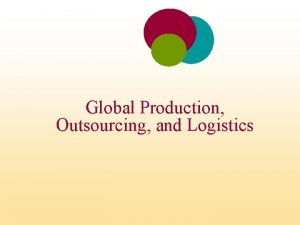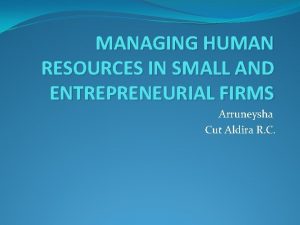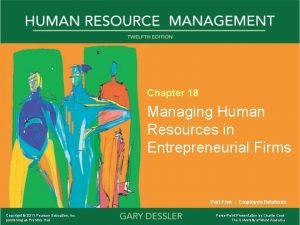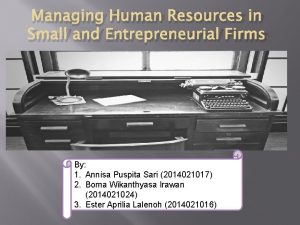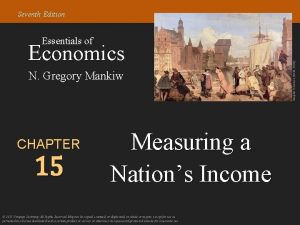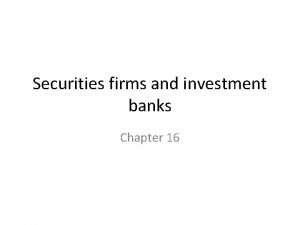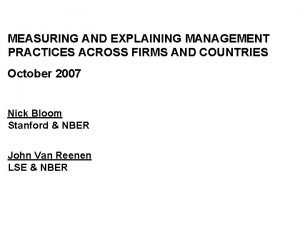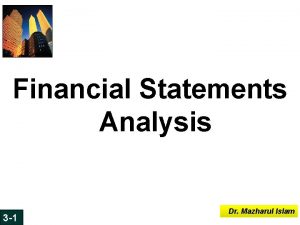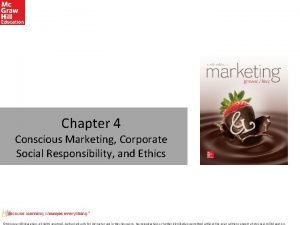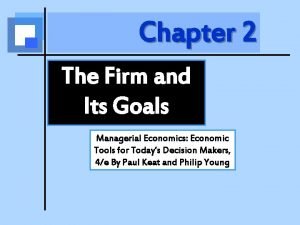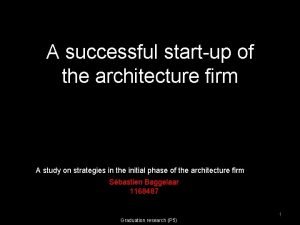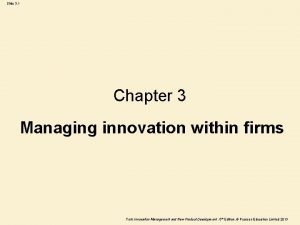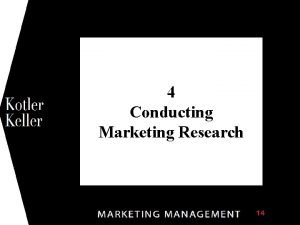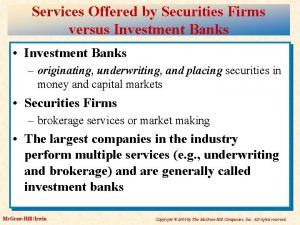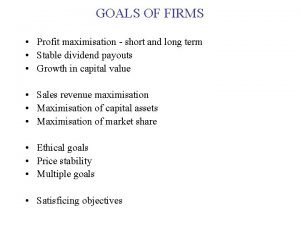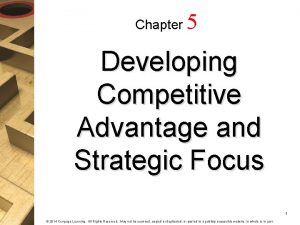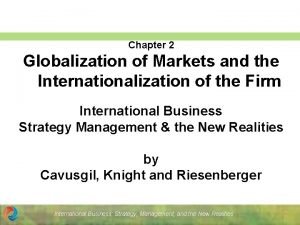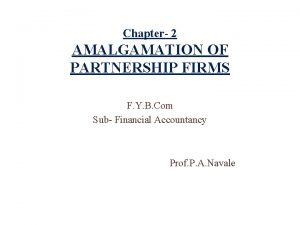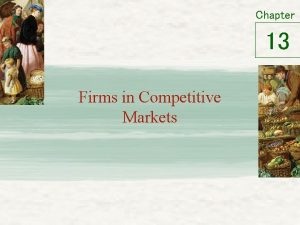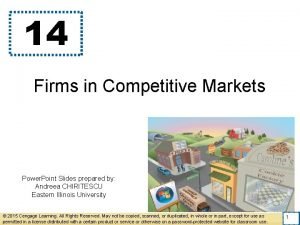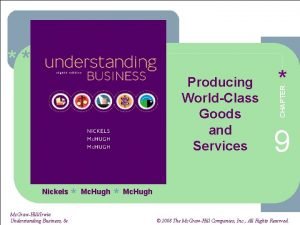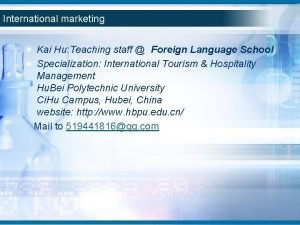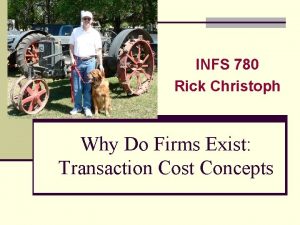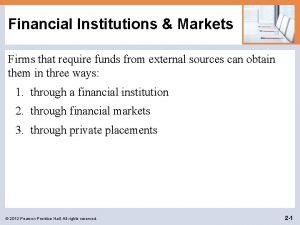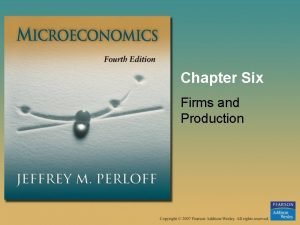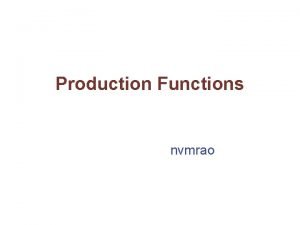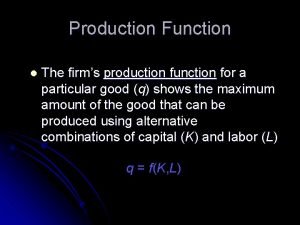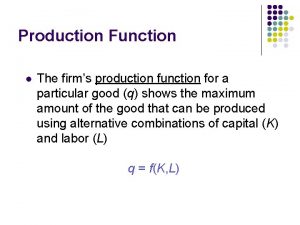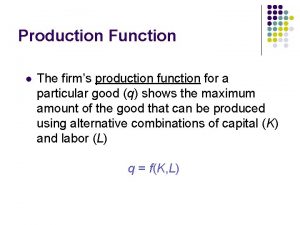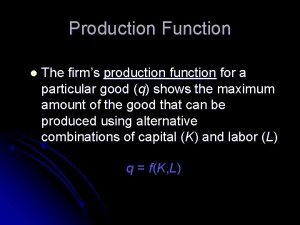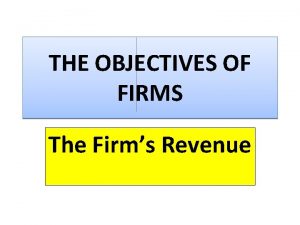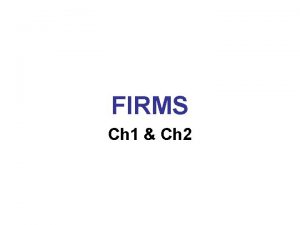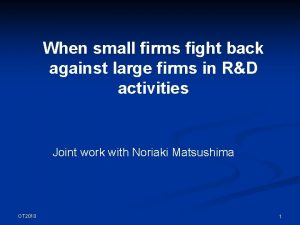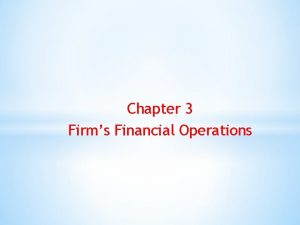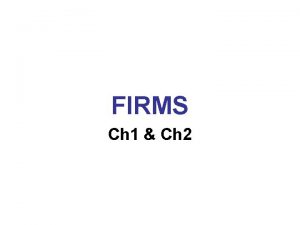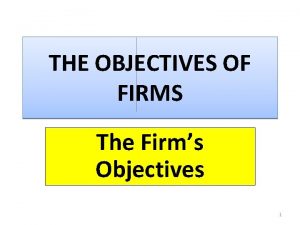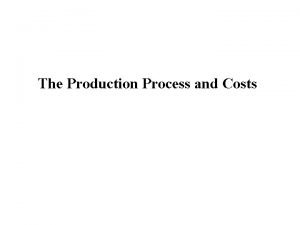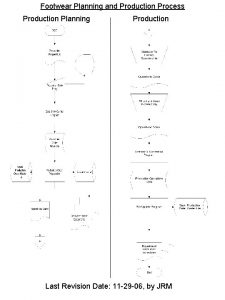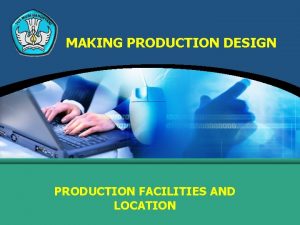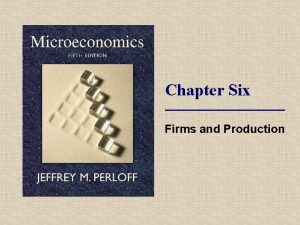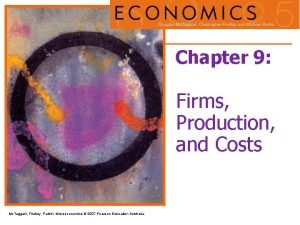Firms and production 3 6 Firms and production






























- Slides: 30

Firms and production 3. 6 Firms and production 3. 7 Firm’s costs, revenue and objectives and production 3. 8 Market structure

The demand for factors of production Factors of production are the resources used to produce goods and to provide services. The four factors of production, or factor inputs, are: • Land - natural resources used in the production process, such as raw materials, fish and physical land. • Labour - the physical and mental human input into the production process. This includes the level of skills, qualities and qualifications of the workforce, and not only the number of workers. • Capital - manufactured goods used to produce other goods and to provide services, such as tools, machinery, vehicles, computers, factories, roads and money. • Enterprise - risk-takers who provide the ideas and resources to organise the other three factors of production in the pursuit of profit. 1/10/2022 In general, the demand for any factor of production is a derived demand. This means that the demand for factors of production depends on the demand for the goods and services that they will be used to produce. For example, economics lecturers at university arc hired only if there is demand for economics courses from undergraduates. On a macroeconomic scale, the demand for the factors of production in a country results from the total level of demand for goods and services in an economy. For instance, during an economic recession, fim 1 s will demand less labour. Mohammad Ziaul Alam, HOD, DEBS, Zia-academy. com 2

Derived demand for factors of production In addition to the derived demand for factors of production, the demand for land, labour and capital also depends on their cost, availability and quality. • The cost of factors of production - The higher the cost of land, labour and capital, the lower their demand tends to be. For example, Apple outsources the production of its i. Phones and i. Pads to Foxconn, a Taiwanese manufacturer based in China, due to the relatively lower costs of land labour. Similarly, if labour costs arc relatively high compared with the cost of capital then workers might be replaced by machinery and technology. Also, the demand for capital depends on the cost of borrowing money - that is, interest rates. 1/10/2022 • The quantity (or availability) of land, labour and capital - The greater the availability of factors of production, the lower their cost tends to be, and hence the higher their demand. For example, the relatively large size and availability of the workforce in India and China has boosted the demand for labour from multinationals seeking to expand their operations. In general, the greater the quantity of a factor of production, the lower its cost tends to be. • The quality of land, labour and capital – Higher quality resources tend to demand a higher price. For example, surgeons, pilots and barristers are in high demand due to their highly valued skills and qualifications. China, India, Vietnam and Thailand have good-quality land to grow rice, whereas Scandinavian countries do not have the natural climate to do so. Mohammad Ziaul Alam, HOD, DEBS, Zia-academy. com 3

Labour-intensive and capital-intensive production The production or provision of different goods and services requires varying amounts of factors of production. In labourintensive industries, the use and cost of labour is proportionately higher than the cost of other factors of production. Examples are teaching, psychiatry, sports coaching and management consultancy. By contrast, in capital-intensive industries the use and cost of capital is more than that of any other factor of production. Examples are car manufacturing, soft drinks production and oil extraction. Labour-intensive production A labour-intensive firm is one that spends proportionately more on labour as a percentage of its total costs of production. Traditional forms of agricultural farming and fishing arc examples of labour-intensive production. It is also commonplace in economically developed nations that specialise in the output of services, such as accountancy, physiotherapy, real estate services and tourism. Labour-intensive production can be very expensive. For example , in private fee paying schools and health clinics, labour costs account for the largest proportion of production costs, so the price charged to customers is relatively high. Labour-intensive production processes tend to be used to produce individual or personalised products on a relatively small scale. 1/10/2022 Capital-intensive production takes place ifa firm spends more on capital costs than on any other factor of production. This will include the expenditure on capital equipment such as tools, equipment, machinery and vehicles. Capital-intensive firms, such as aircraft and motor vehicle manufacturers, therefore need a lot of money to fund their operations. This can act as a barrier to entry into the industry, since it is difficult for new firms to enter such industries. Mohammad Ziaul Alam, HOD, DEBS, Zia-academy. com 4

Factors affecting capital- or labour-intensive production Whether firms choose more capital- or labour-intensive production methods depends on several related factors: • The cost of labour compared with the cost of capital - Firms will tend to choose more capital-intensive methods of production if labour costs are relatively high (assuming that it is possible to substitute factors inputs in the production process), and vice versa. • The size of the market - Capital-intensive production tends to take place for mass-market products such as soft drinks, passenger vehicles and consumer electronics. Labour-intensive methods are often used for personalised services, such as a private tutor, counsellor, adviser, instructor or coach. • The firm's objectives - Profit-maximisers operating in mass markets tend to opt for capital-intensive production methods in order to minimise their unit costs of production. Other firms might choose to use labour-intensive methods as they operate on a smaller scale or to safeguard jobs. Black & Decker, operating in Shenzhen, China, uses labour-intensive production methods to create jobs in the special economic zone (see Chapter 16), benefiting from tax incentives from the government. 1/10/2022 Mohammad Ziaul Alam, HOD, DEBS, Zia-academy. com 5

Productivity is a measure of how well resources are used in the production process: that is, the economic efficiency of land, labour, capital and enterprise. For example, labour productivity measures the efficiency of the workforce in terms of output per worker. It can be improved by having a better-skilled workforce (through education and training) or by allowing workers to use better, more efficient technologies to increase their output. By contrast, the use of automation, such as the robotics and specialised computer equipment used in car manufacturing, can help to raise capital productivity without the need to hire more workers. 1/10/2022 Mohammad Ziaul Alam, HOD, DEBS, Zia-academy. com 6

Importance of productivity • • • 1/10/2022 Economies of scale Higher profits Higher wages Improved competitiveness Economic growth Mohammad Ziaul Alam, HOD, DEBS, Zia-academy. com 7

Determinants of productivity • • • Investment Innovation Skills and experience Entrepreneurial spirit Competition 1/10/2022 Mohammad Ziaul Alam, HOD, DEBS, Zia-academy. com 8

Costs of production Costs are the payments made by firms in the production process. Examples of costs of production include: • wages and salaries paid to employees • rem paid to landowners for hiring of business premises • advertising expenses • purchases of raw materials and components from suppliers • utility bills for telephone, gas and electricity services • dividend payments to shareholders • taxes paid to the government based on the value of company profits made 1/10/2022 Mohammad Ziaul Alam, HOD, DEBS, Zia-academy. com 9

Fixed costs are the costs of production that have to be paid regardless of how much a firm produces or sells. For example, salaries for senior managers, insurance payments and rem all have to be paid regardless of the firm's output level. This relationship is illustrated in Figure 1/10/2022 Mohammad Ziaul Alam, HOD, DEBS, Zia-academy. com 10

Variable costs are costs of production that change when the level of output changes. Examples are the costs of raw materials or components needed to build houses – the more houses that are built, the higher these variable costs become. The total variable cost line starts at the origin because when there is no output, no variable costs are incurred. 1/10/2022 Mohammad Ziaul Alam, HOD, DEBS, Zia-academy. com 11

Total costs As the name suggests, the total costs of production arc the sum of all fixed and variable costs. The total cost line, shown in Figure 12. 3, starts at the same value as fixed costs because even when nothing is produced, fixed costs still ha, ·e to be paid by the firm. Total costs = fixed costs + variable costs 1/10/2022 Mohammad Ziaul Alam, HOD, DEBS, Zia-academy. com 12

Average costs refer to the total cost of making one product - it is the unit cost of production. Average costs= total costs+ output level Firms that operate on a large scale arc able to reduce their average costs of production. For example, Coca-Cola's bottling plants can produce 10 OOO cans of soft drinks per minute. This enables Coca-Cola to benefit from lower unit costs of production, as shown in Figure. Here, the firm is able to enjoy economies of sca le (lower average costs as it expands output from Oa to Ob). If the firm becomes to 0 large, by operating beyond Ob, it will suffer from inefficiencies, thus leading to diseconomies of scale. 1/10/2022 Mohammad Ziaul Alam, HOD, DEBS, Zia-academy. com 13

Calculating TC, TFC, TVC, AFC 1/10/2022 Mohammad Ziaul Alam, HOD, DEBS, Zia-academy. com 14

Economies of Scale One meaning of the word 'economy' is reduced expenditure or saving, while the word 'scale' refers to size. Therefore the phrase 'economies of scale' means that average costs of production fall as a firm grows or increases output. 1/10/2022 Mohammad Ziaul Alam, HOD, DEBS, Zia-academy. com 15

Diseconomies of scale arise when a firm gets too large and average costs of production Start to rise. Therefore, the disadvantages of growth start to outweigh the advantages 1/10/2022 Mohammad Ziaul Alam, HOD, DEBS, Zia-academy. com 16

Revenues Revenue refers to the money payable to a business from the sale of its products. For example, Nike and Adidas receive most of their revenues from the sale of sports apparel and sports equipment. According to its website, Mc. Donald's - the world's largest restaurant chain, with over 34 OOO restaurants worldwide - earned around $28 billion of revenue in 2013 from the sale of fast food. Revenue is often referred to as sales revenue or sales turnover. It is calculated by using the formula: Revenue = price x quantity sold For example, if a cinema charges an average price of $IO for a movie and manages to sell 5500 tickets in a week, its total revenue will be $55 OOO (that is, $10 x 5500). Average revenue refers to the typical price received from the sale of a good or service. It is calculated using the formula: Average revenue = total revenue ÷ quantity sold So, if instead the cinema earns $60 OOO from the sale of 7500 tickets, the average revenue (or average price) would be $60 OOO ÷ 7500 = $8 per ticket. 1/10/2022 Mohammad Ziaul Alam, HOD, DEBS, Zia-academy. com 17

Average & Total Revenue curve in a perfectly competitive firm & imperfectly competitive firm 1/10/2022 Mohammad Ziaul Alam, HOD, DEBS, Zia-academy. com 18

Business objectives Businesses have a variety of objectives and do not necessarily strive to maximize profit. Other business objectives include: • Survival - While business survival is a vital objective for new businesses, even well-established firms will need to focus on this, especially during unfavourable trading times. To survive in the long run, firms need to earn a profit. • Market share - TI 1 is refers to a firm's sales revenues as a proportion of the industry's total sales revenue. An increase in sales revenues will, other things being constant, lead to greater market share for the firm. Higher market share has several advantages, such as economics of scale and customer loyalty. 1/10/2022 • Image and reputation - Businesses might aim to improve how the general public perceives them. A bad image can turn suppliers and customers against the firm's products and services. For example, German car-maker BMW recalled 720000 cars worldwide in 2013 due to potential electrical problems. Re solving such problems, although costly to BMW, prevents problems for the firm in the long run. • Ethical objectives - This refers to the moral principles (values and beliefs) that guide business activity. These objectives focus on what is considered to be socially responsible. Ethical businesses strive to improve the treatment of workers, customers, shareholders and the natural environment. Not-for –profit organisations such as charities aim to provide services to enhance the welfare of people in society. Mohammad Ziaul Alam, HOD, DEBS, Zia-academy. com 19

Profit and profit maximisation A firm earns profit if its total revenues exceed its total costs of production. Profit is calculated by using the formula: Profit=total revenue -total costs Profit provides an incentive for entrepreneurs to take risks. Without profit, firms will struggle to survive in the long run. Profit maximisation and business o bjectives Profit maximisation is the goal of most private-sector firms. Profits are maximized when the positive difference between a firm's sales revenues and its costs of production is at its greatest. 1/10/2022 Mohammad Ziaul Alam, HOD, DEBS, Zia-academy. com 20

Relationship in cost, Revenue & Profit 1/10/2022 Mohammad Ziaul Alam, HOD, DEBS, Zia-academy. com 21

Effects of Changing Profit & ways of increasing profit Effects of changes in profit Ways of increasing profit Profits provide an incentive for entrepreneurs to undertake production. An in increase in profit will encourage more firms to enter in a competitive market. It will also provide firms with more finance to update their capital equipment and expand their business. A profitable firm will also find it easier to obtain external finance. Shareholders are more likely to want to buy shares in profitable firms and banks are usually willing to give them loans. These firms may also find it easier to recruit top managers and directors, attracted by their success. The two fundamental ways of increasing profit are to- • To reduce costs of production • To raise revenue - increasing price - increasing sales The effect of a fall in profit may vary with time. At first it may have little impact on the behaviour of firms, if they think that it will only be short lived. After a while, if profits remain low, or fall further, some firms will cut back on production and others will cease production. 1/10/2022 Mohammad Ziaul Alam, HOD, DEBS, Zia-academy. com 22

Perfect competition In economics, the term market structure refers to the key characteristics of a particular market. These features include the number and size of firms in the market, the degree and intensiry of price and non-price competition, and the nature of barriers to entry. The two extreme marker structures in economics arc perfect competition and monopoly. The model of perfect competition describes a marker where there is immense competition. A real world example is the wet markets (fresh food markets) commonly found in Asian countries such as Hong Kong, Singapore, South Korea, Taiwan and Macau. 1/10/2022 Mohammad Ziaul Alam, HOD, DEBS, Zia-academy. com 23

characteristics of firms in perfect competition The main characteristics of firms in perfect competition are as follows: • There are many buyers and sellers in the industry, none of which has any significant market power to influence the market supply or demand • Hence, firms arc said to be price takers - the price they charge is determined by the market forces of demand supply rather than firms setting their own prices. • As there arc literally no barriers to entry in perfect competition , there is freedom of entry to, and exit from, the market. • Firms produce a homogeneous product. This means that the products being sold are identical, such as bananas or strawberries being sold in fresh fruit markets. • Both buyers and sellers have perfect knowledge. However, perfect competition is a theoretical possibility only and in reality the vast majority of markets are imperfect. For example: • In most industries, there are market leaders (those with a high market share) who have significant power to influence the market supply and hence prices. • In reality, barriers to entry exist in virtually all markets. • Consumers and suppliers are likely to have imperfect knowledge rather than perfect knowledge. • Firms are likely to produce differentiated product s, rather than homogeneous ones Slogan: Impossible is nothing –Adidas; The ultimate driving machine –BMW; The world's online market price- e. Bay; The world on time – Fed. Ex; The world's local bank- HSBC; Because I'm worth it - L'Oreal; I'm lovin' It -Mc. Donald's; Where do you want to go today? - Mic: rosoft; Just do it -Nike 1/10/2022 Mohammad Ziaul Alam, HOD, DEBS, Zia-academy. com 24

Pricing and output policies in perfect competition A high degree of competition in a market can benefit consumers. This is because they get good-quality products and good customer service, all ar the right prices. In addition, competition brings about greater choice, higher output and more competitive prices 1/10/2022 Mohammad Ziaul Alam, HOD, DEBS, Zia-academy. com 25

Monopoly There are different interpretations of what is meant by a monopoly. In general, a monopoly is a marker structure where one supplier dominates the market. Examples arc Coca-Cola (carbonated soft drinks), YKK (zip fasteners) and Mabuchi (which makes around 90 per cent of the micro-motors used to adjust rear-view mirrors in cars). A pure monopoly exists if only one firm supplies the whole market. In the USA, this would include the United Stares Postal Service (the only service provider of first class postage) and the Federal Reserve (the sole supplier of bank notes and coins). The word 'monopoly' comes from the Greek language, with monos meaning one and polein meaning to sell. Hence, monopoly can be defined as a market structure where there is only one supplier of a good or service. 1/10/2022 Mohammad Ziaul Alam, HOD, DEBS, Zia-academy. com 26

Features of monopoly include • Single supplier - As its name suggests, a monopolist is the sole supplier of a product in a given market. This is due to high barriers to entry (see below), which result in a lack of substitutes. • Price maker (or price setter) - The monopolist has significant market power, controlling enough of the market supply that it can charge higher prices yet produce lower output than would be the case if it faced real competition. 1/10/2022 • Imperfect knowledge - A monopolist is able to protect its prestigious position because customers and rivals ha"e imperfect knowledge, partly as a result of the monopolist's ability to protect its trade secrets. • High barriers to entry - A monopolist can remain so only if in the long run there are wry high barriers to entry. These obstacles effectively prevent other firms from entering the market. Examples include: economies of scale of existing firms, ownership of essential resources, the existence of intellectual property rights (namely, patents, trademarks and copyrights), advertising expenditure and legal barriers to entry. Mohammad Ziaul Alam, HOD, DEBS, Zia-academy. com 27

Pricing and output policies in monopoly Due to the lack of competition, the monopolist is able to restrict market supply. This is shown in Figure 13. 2 by the shift in supply from S 1 to S 2 , which reduces output from 2 to Qi. Alternatively, we can say that supply would be higher at S 1 in the absence of monopoly power. As the monopolist limits the supply of its good or service, the price is higher (at P 2 rather than P 1). Monopolists are also able to use price discrimination. This is the practice of charging different prices to different customers for essentially the same product. For example, public transport operators, theme parks and cinemas charge students different prices compared with other adults. Another example, often used by supermarkets, is price discrimination based on the quantity sold. For example, supermarket customers who buy 'multipacks' of a product usually get to enjoy a lower price for each unit bought. This discriminates against those who buy in smaller quantities. 1/10/2022 Mohammad Ziaul Alam, HOD, DEBS, Zia-academy. com 28

Other pricing policies • Cost-plus pricing • Competition -based pricing • Penetration pricing • Loss leader pricing • Price skimming • Promotional pricing 1/10/2022 Mohammad Ziaul Alam, HOD, DEBS, Zia-academy. com 29

Business growth Size of firms • The number of employees • The size of the market (market share) • The capital employed in a firm • The sales turnover (sales revenue) of the firm How do firm s grow? lntemal growth (organic growth) • by increasing the number of branches • by fra nchising • attract investment from larger businesses External growth (inorganic growth) • Takeovers • Mergers 1/10/2022 Mohammad Ziaul Alam, HOD, DEBS, Zia-academy. com 30
 Tahapan pre production
Tahapan pre production Global production, outsourcing, and logistics
Global production, outsourcing, and logistics Strategy and organization in the international firm
Strategy and organization in the international firm Managing human resources in small and entrepreneurial firms
Managing human resources in small and entrepreneurial firms Managing human resources in small and entrepreneurial firms
Managing human resources in small and entrepreneurial firms Managing human resources in small and entrepreneurial firms
Managing human resources in small and entrepreneurial firms Households and firms circular flow model
Households and firms circular flow model Securities firms and investment banks
Securities firms and investment banks Management practices across firms and countries
Management practices across firms and countries At the most fundamental level firms generate cash and
At the most fundamental level firms generate cash and Todays public relations departments
Todays public relations departments Firms nasa fire map
Firms nasa fire map Nasa's fire information for resource management system
Nasa's fire information for resource management system Understanding how csr differs from conscious marketing
Understanding how csr differs from conscious marketing The goal of the firm should be
The goal of the firm should be Startup architecture firm
Startup architecture firm Pearson’s uncertainty map
Pearson’s uncertainty map Specialty line marketing research firms
Specialty line marketing research firms Securities firms vs investment banks
Securities firms vs investment banks Natural forms in nature
Natural forms in nature Baumol model formula
Baumol model formula Developing a firms strategy canvas focuses on
Developing a firms strategy canvas focuses on For internationalizing firms the consequences
For internationalizing firms the consequences Amalgamation of two partnership firms
Amalgamation of two partnership firms Perfectly competitive short run supply curve
Perfectly competitive short run supply curve Firms in competitive markets chapter 14 ppt
Firms in competitive markets chapter 14 ppt Cad has productivity in many firms
Cad has productivity in many firms Most firms practice the selling concept when they face
Most firms practice the selling concept when they face Why do firms exist
Why do firms exist Nasa firms fire
Nasa firms fire Firms that require funds from external sources
Firms that require funds from external sources

